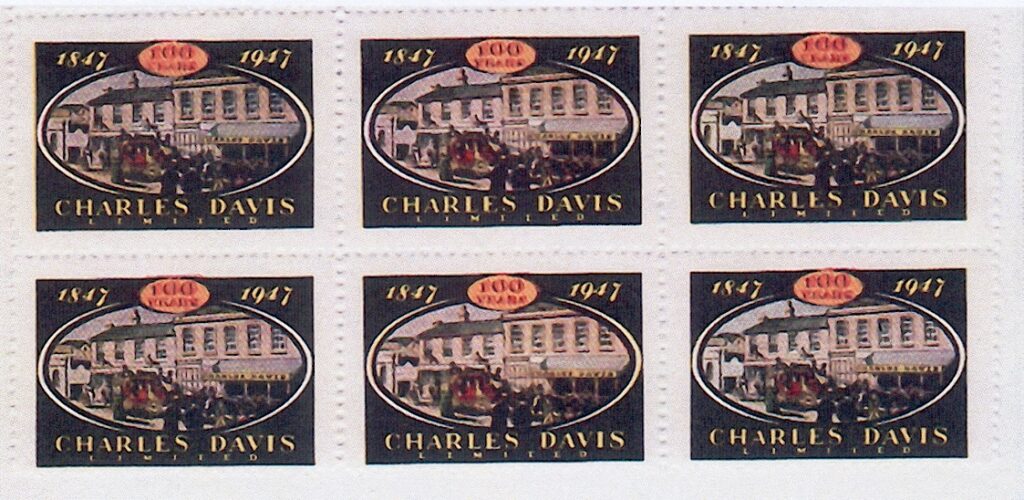To date, this is the only Australian paper at this website devoted to a ‘Cinderella’, a non-postal item with no postal value, although rare covers get through the postal system without being taxed. This block of six celebrates the Centenary of Charles Davis arriving in Tasmania in 1847 and the centre of the design illustrates the store which was known as Charles Davis Limited (Figure 1).

Charles Davis, businessman, was born in London in ?1824, son of Thomas Davis, carriage-lamp maker, and his wife Ann. He showed an early interest in shops by robbing a till in 1840, and on 5 April 1841, at the London Central Criminal Court, he was sentenced to ten years transportation for a second offence, larceny from the person, nominally the theft of a silk handkerchief. After ten months in the hulks he sailed for Hobart aboard the Candahar, arriving in July 1842. Set to work at Bridgewater and Oyster Cove as a tinsmith, he received his ticket-of-leave in September 1847 and established a small tin and copper-smithing enterprise in a Bathurst Street shed. In October 1848, having ‘only three records of a trifling nature … made against him’, Davis was recommended for the conditional pardon he received in December next year. After a try at Victoria’s gold in 1851-52, he returned to his Hobart business.
Davis’s rise to prosperity as a hardware merchant was reflected in his private life. The first of his five wives, Emma Hurst, whom he married on 11 September 1848 at St John’s Presbyterian Church, was the 16-year-old daughter of a Cambridgeshire horse-stealer. Before her death in 1867 he entered the Memorial Congregation, becoming a respected deacon (1888-91, 1892-95) and representative at Congregational Unions (1894-97). He married Emma Cheshire Bolter, an emancipist’s daughter, on 3 April 1868 at the Upper Murray Street Congregationalist Church. Emma died in December that year and on 20 January 1870 Davis married her sister Kezia Cheshire.
Davis flourished in the boom of the 1880s, with the metal-mending and manufacturing workshop becoming augmented by an importing and distributing enterprise. His dissimilar sons, half-brothers Charles junior (b.1865) and Alfred (b.1873), entered the business and eventually replaced Davis in responsibility for the running of two sections. Kezia’s death in 1883 brought Davis to wed middle-class, free immigrant, widowed schoolteacher Sarah Anne Blackmore on 31 July 1884. Twelve years later she died and on 28 March 1899 he married Mary Ann Harby, widow of a master mariner.
In 1911 Davis’s business was floated as a company with Charles junior and Alfred as managers, but the senile Charles senior, small and tattooed continued to attend the store daily until his death on 21 April 1914. Survived by his fifth wife and his two sons and six daughters, he was buried in Cornelian Bay cemetery after a well-attended funeral at the Holy Trinity Anglican Church. In 1905 Davis had donated the rent of a Murray Street site to the Young Men’s Christian Association and gave £1000 to the building fund. But tales of his alms-giving are largely apocryphal: his estate, valued for probate at £69,530, was, apart from the Young Men’s Christian Association site, divided amongst the clan he had founded.
The following information about the company was derived from the Charles Davis website: Charles Davis established a hardware, ironmongery and tinsmithing business which grew to become one of Tasmania’s major business enterprises. Sir Donald Trescowthick took over the controls of the business from the Davis family in the 1970s. Under his management, the company embarked on a significant expansion and diversification. At various times the company had investments in wholesaling, retailig, car distribution, property, hotels and motels, and mining. At its height, the company was Australia’s fourth largest retailer, after acquiring many significant regional retailers, including Harris Scarfe, Cox Foys, Fitzgerald’s department stores, Lloyd’s hardware stores, Campbell’s hardware store and McEwans. Also the company owned Co-operative Motors, a major Tasmanian car dealer.
The company was renamed as Harris Scarfe Holdings Ltd in 1995. After the change in name, the company focussed on its departmental store activities and divested all other activities. The company merged its Harris Scarfe and Fitzgerald’sretailing operations, which continued to grow to become Australia’s third largest departmental store group.
The company was placed in receivership in 2001, after suffering financial difficulties. The Harris Scarfe chain of stores was sold and continues to trade to-day under new ownership.
The initial portion of this paper was excerpted from the Australian Dictionary of Biography.